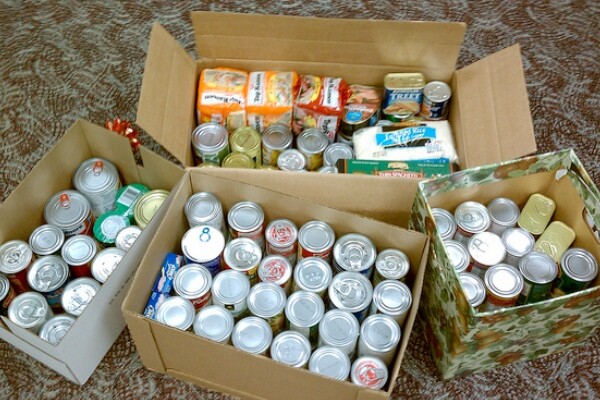Are Nutritional Needs Considered At Food Banks?

If you've ever taken part in a food drive, you know what kinds of items generally end up in the donation piles. Mostly canned food and processed items: sugar, salt, fat, and lots of it. It's easy to understand why those items end up in the donation piles: They're generally the cheapest things to purchase.
But do those donations really help people in need?
A piece published in The Atlantic examines the problem of not only making sure that people living in low income environments have enough food to eat, but making sure they have enough healthy food to eat. (The author of the piece takes the approach that making healthier food easy to obtain is a way to provide preventative healthcare; if people eat healthier food, they'll be less likely to end up in hospitals and clinics down the road.) But how do nutritional requirements factor into what food ends up being handed out at shelters? To find out, I called up the Los Angeles Regional Food Bank.
To give you a bit of a primer, the L.A. Food Bank's job is to actually obtain the food that is then delivered to more localized agencies and programs that, in turn, distribute the food to people and families in need. Which means, they're the first step in getting the food that ends up being handed out. They obtain their food from a combination of drives, donations from large organizations, and through actual purchases they make themselves.
To keep track of the nutritional value of the food they receive, the Food Bank uses an internal ranking program that's a modified version of the Greater Pittsburgh Food Bank's Choosing Healthy Options Program. For every piece of food that's considered for purchase, information from the food label is entered into a spreadsheet that contains algorithms determining the nutritional value of the product. Using a red/yellow/green light system -- green being healthy, red not -- the Food Bank can determine how valuable the item is from a nutritional standpoint.
"A little over 50 percent received -- that includes donations and purchased items -- is green or yellow," says Maricelle Ranola, the Nutrition Director of the L.A. Food Bank. "What we're distributing is about 65 percent green or yellow. I'm hoping we get to a point where it's 100 percent green." But is that a realistic goal?
As any grocery shopper knows, there's a big difference in price between healthy items and junk food. Buying organic versus non-organic is mostly a decision based on how much money you're willing to spend, as is the decision to even step into a store like Whole Foods versus something like the 99 Cent Store. We all pay a premium for healthy food, so how does the higher price point affect purchasing for the Food Bank?
"Lately the trend has been a little better," Ranola says, "but it is still a little bit more expensive for the greener items. It's not a huge issue for us, but it is still an issue."
This price difference only affects the Food Bank when it comes to what items they purchase themselves. The other area where they can hope to raise the level of "green" and "yellow" items without having to worry about putting a giant hole in their budget is through donations.
"When it comes food drives, we appreciate whatever comes in," Ranola says. "But people should still be conscious when they donate, that the food bank is not just the place to donate every food. We're also looking for foods with nutritious quality as well."
This means instead of just dropping off whatever cans of junk food you have lying around, to actually donate worthwhile items like fruits and vegetables. Because, frankly, all food is not the same, and some does more harm than good.
"There are a lot of other diseases out there that lower income families see more than the ones that are mid- to higher-class individuals," Ranola says. In addition, donating healthy food makes a strong point about how we should treat the lesser fortunate. "Even though they are lower income, it doesn't mean they should get the bottom barrel of the food."


